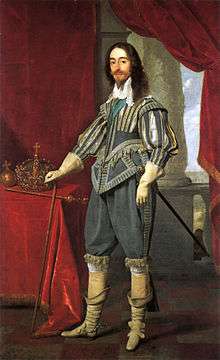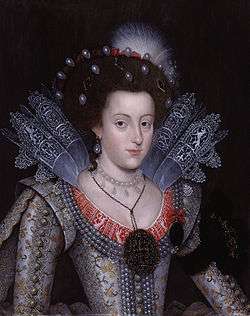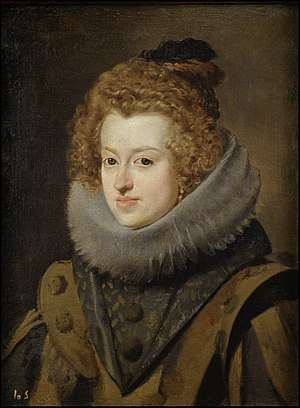Spanish match
The Spanish match[1] was a proposed marriage between Prince Charles, the son of King James I of Great Britain, and Infanta Maria Anna of Spain, the daughter of Philip III of Spain. Negotiations took place over the period 1614 to 1623, and during this time became closely related to aspects of British foreign and religious policy, before breaking down completely.

The policy, unpopular with England's Protestant House of Commons, where the recent Anglo-Spanish War had not been forgotten, was initiated during the embassy to England of Gondomar, who arrived in London in 1614 with the offer that Spain would not interfere with James's troubled rule in Ireland if James would restrain the English "privateers" in Spanish American waters. Further, he proposed a marriage alliance, offering a dowry of £500,000 (later increased to £600,000), which seemed especially attractive to James after the failure of the Parliament of 1614 to provide him with the financial subsidies he requested.
The climax of the ensuing decade of high-level negotiation to secure a marriage between the leading Protestant and Catholic royal families of Europe occurred in 1623 in Madrid, with the embassy of the Prince Charles and James's favourite, George Villiers, 1st Duke of Buckingham. The wedding never took place despite the signing of a marriage contract by King James; criticism instead led to the dissolution of Parliament.
Background

A Spanish marriage for Henry Frederick, Prince of Wales, Charles's elder brother who had died in 1612, had been proposed by his mother Anne of Denmark.[2] After his death she supported the idea of a Spanish marriage for her daughter Elizabeth, but in 1613 Elizabeth married a prominent Protestant prince.[3] For her second son Charles, there were candidate marriages mooted from Savoie and Tuscany, as well as Spain and France. From 1614 to her own death in 1619, Queen Anne gave some support to a Spanish match, preferring at times a French marriage, and recognising that the Spanish proposals were entirely based on self-interest.[4] A point brought up against it in 1620 was that the previous "Spanish matches", those that had brought Catherine of Aragon to England, and Philip II of Spain to marry Queen Mary, had in the popular memory turned out badly.[5]
James I's policy
At the beginning of 1618 James I and VI was in a strong diplomatic position. His efforts against wars in Europe had been largely effective, and his own status as a Protestant ruler who was on good terms with Catholic powers was high. Success in reducing the religious factor in international relations then deteriorated for James, in parallel with the failure of the Spanish Match, with the onset of the Thirty Years' War.[6] In 1618 he was still concerned with detailed moves to improve his relationship with Spain, such as the translation of the anti-Calvinist Bishop Lancelot Andrewes,[7] and the execution of the buccaneering Sir Walter Raleigh.[8]
On the domestic front, the prospect of a Spanish dowry from a marriage between his heir Charles, Prince of Wales from 1616, and Infanta Maria Anna of Spain, was a potential source of income for James, who sought ways to rule without depending on the Commons for subsidies.[9] The policy of the Spanish Match was supported by the Howards and other Catholic-leaning ministers and diplomats—together known as the "Spanish Party"—but deeply distrusted by some Protestant groups in England. Sentiment was voiced vociferously in the Commons when James called his first parliament for seven years in 1621 to raise funds for a military expedition in support of Frederick V, Elector Palatine, his son-in-law.
There was in fact no chance that Pope Paul V would have issued the required dispensation for the Infanta to marry a Protestant. This fact was known to the Spanish king, but apparently Gondomar was kept in ignorance of the correspondence.[10] Paul V died early in 1621, and his successor Pope Gregory XV was thought amenable to the idea of the match. James sent George Gage to Rome to lobby, putting the case on behalf of English Catholics.[11] The matter was passed to a small group of cardinals, who emphasised that improved treatment for English Catholics was a prerequisite.[12]
Political opposition
By the 1620s, events on the continent had stirred up anti-Catholic feeling to a new pitch. A conflict had broken out between the Catholic Holy Roman Empire and the Protestant Palatinate, when the Bohemians deposed the Emperor as their king and elected James's son-in-law, Frederick V, Elector Palatine, in his place, triggering the Thirty Years' War.[13] James reluctantly summoned parliament as the only means to raise the funds necessary to assist his daughter Elizabeth and Frederick, who had been ousted from Prague by Emperor Ferdinand II in 1620. The Commons on the one hand granted subsidies inadequate to finance serious military operations in aid of Frederick,[14] and on the other called for a war directly against Spain.[15]
In November 1621, led by Sir Edward Coke, the Commons framed a petition asking not only for a war with Spain but for Prince Charles to marry a Protestant, and for enforcement of the anti-Catholic laws. When James heard of the petition, he is said to have cried, "God give me patience".[15] James flatly told them not to interfere in matters of royal prerogative or they would risk punishment;[16] to which provocation they reacted by issuing a statement protesting their rights, including freedom of speech. James wrote: "We cannot with patience endure our subjects to use such anti-monarchical words to us concerning their liberties, except they had subjoined that they were granted unto them by the grace and favour of our predecessors."[17] Urged on by Buckingham and the Spanish ambassador Gondomar, James ripped the protest out of the record book and dissolved Parliament.[18]
Opposition literature, censorship and imprisonment
Outside the political process, feelings that were both anti-Spanish and anti-Catholic ran high. Pamphleteering attacks aimed at the Spanish Match through the court, deploying "defamation, forgery and partisan distortion". Smears in the form of fabricated personal details about figures associated with the Spanish Party were published, especially by the Puritan faction.[19] Thomas Scott is particularly noted for his part in this campaign, from 1619.[20]
In 1620, and again in 1621, James issued decrees against writing or speaking on state affairs.[21] John Everard preached against the match in February 1621, at St Martin-in-the-Fields, and spent about half a year in the Gatehouse Prison.[22] When Robert Mason wrote in 1622 to his friend Thomas Hobbes about public opinion on the match, criticising James's policy and noting Gondomar's skill in gaining support for it by holding out the prospect of the Palatine being returned to Frederick V, he hedged his comments with pleas for secrecy.[23]
Thomas Middleton's 1624 play A Game at Chess allegorized the events surrounding the Spanish Match. It was particularly harsh on Gondomar, represented by the Black Knight. Plays were in any case censored, and Henry Herbert as Master of the Revels passed it for performance; it was a short-lived succès de scandale in August 1624. It has been suggested that Herbert connived at the unheard-of dramatic liberties taken in portraying members of the royal family, in a court now dominated by the anti-Spanish party.[24] Plays of the previous two years that had Spanish settings, Middleton and Rowley's The Changeling and Thomas Dekker's Match Me in London, have been given readings that set them against the match, necessarily more covertly.[25]
Charles in Spain

Denied the military option, James ignored public opinion and returned to the Spanish match as his only hope of restoring the possessions of Elizabeth and Frederick. The position was altered, however, by the death of Philip III of Spain, in 1621. With the accession of Philip IV of Spain the Spanish proponent of the marriage, Gondomar, lost influence to Olivares.[26]
When negotiations began to drag, Prince Charles, now 22, and Buckingham decided to seize the initiative and travel to Spain incognito, to win the Infanta directly.[27] Travelling under the names Thomas and John Smith, they arrived in Madrid on 7 March 1623 (OS) to the astonishment of Philip IV, and of the English Ambassador, John Digby, 1st Earl of Bristol, who had been given no warning of the Prince's intentions. Charles and Buckingham were ignorant of the key facts, that Maria Anna was strongly averse to marrying a non-Catholic, and that the Spanish, who had been protracting the marriage negotiations to keep British troops out of the war, would never agree to such a match unless James and Charles pledged to repeal the anti-Catholic Penal Laws.[28]
Though a secret treaty was signed, the Prince and Duke returned to England in October without the Infanta. There was open delight shown by sections of the British people.[29]
The Privy Council
From 1617 the negotiations for the match had been handled by the Privy Council. In fact it was considered that there was a need for confidential dealings with Spanish counterparts, and a subcommittee of the Council was set up for that reason; which later became a vehicle for discussion of foreign policy more generally, and persisted into the next reign.[30] The last word on the Spanish Match was the vote in the Privy Council to reject the Spanish terms, taking place in January 1624.[31]
Aftermath
Affronted by their treatment in Spain, Charles and Buckingham now turned James's Spanish policy on its head: they called for a French match and a war against the Habsburg Spanish empire.[32] To raise the necessary finance, they prevailed upon James to call another Parliament, which met in February 1624. For once, the outpouring of anti-Catholic sentiment in the Commons was echoed in court, where control of policy had shifted from James to Charles and Buckingham,[33] who pressured the king to declare war and engineered the impeachment and imprisonment of the Lord Treasurer, Lionel Cranfield, 1st Earl of Middlesex, when he opposed the idea on grounds of cost.[34]
Lord Bristol, though entirely blameless, was made the scapegoat for the failure of the match: he was recalled in disgrace, ordered to remain on his estates and later imprisoned for a time in the Tower of London. Charles thus antagonised one of his most gifted and trustworthy public servants, and they were not fully reconciled until the outbreak of the English Civil War.
The outcome of the Parliament of 1624 was ambiguous: James still refused to declare war, but Charles believed the Commons had committed themselves to financing a war against Spain, a stance which was to contribute to his problems with Parliament in his own reign.[35] Charles eventually married Henrietta Maria of France.
In popular fiction
The visit of Prince Charles is the background of the novel El capitán Alatriste (1996) by Arturo Pérez-Reverte and its film adaptation.[36]
In 2011, Sophia Institute Press released a novel based on historical events entitled The Spanish Match.[37]
Notes
- Redworth, Glyn (2003). The Prince and the Infanta: The Cultural Politics of the Spanish Match. Yale University Press. ISBN 0300101988.
- Pauline Gregg (1984). King Charles I. University of California Press. p. 73. ISBN 978-0-520-05146-1.
- Clare McManus (2002). Women on the Renaissance Stage: Anna of Denmark and Female Masquing in the Stuart Court (1590-1619). Manchester University Press. p. 136. ISBN 978-0-7190-6250-6.
- Meikle, Maureen M.; Payne, Helen. "Anne". Oxford Dictionary of National Biography (online ed.). Oxford University Press. doi:10.1093/ref:odnb/559. (Subscription or UK public library membership required.)
- Healy, Simon. "Alured, Thomas". Oxford Dictionary of National Biography (online ed.). Oxford University Press. doi:10.1093/ref:odnb/70628. (Subscription or UK public library membership required.)
- W. B. Patterson (14 September 2000). King James VI and I and the Reunion of Christendom. Cambridge University Press. pp. 294–6. ISBN 978-0-521-79385-8.
- McCullough, P. E. "Andrewes, Lancelot". Oxford Dictionary of National Biography (online ed.). Oxford University Press. doi:10.1093/ref:odnb/520. (Subscription or UK public library membership required.)
- Derek Hirst (1999). England in Conflict 1603–1660. Arnold. p. 103. ISBN 0 340 62501 5.
- Willson, p 357.
- Glyn Redworth (1 January 2003). The Prince and the Infanta: The Cultural Politics of the Spanish Match. Yale University Press. p. 16. ISBN 978-0-300-10198-0.
- W. B. Patterson (14 September 2000). King James VI and I and the Reunion of Christendom. Cambridge University Press. p. 318. ISBN 978-0-521-79385-8.
- Loomie, A. J. "Gage, George". Oxford Dictionary of National Biography (online ed.). Oxford University Press. doi:10.1093/ref:odnb/10270. (Subscription or UK public library membership required.)
- Willson, pp 408–416.
- Willson, p 417.
- Willson, p 421.
- Willson, p 442.
- Quoted by Willson, p 423.
- Willson, p 243.
- Robert Post (1998). Censorship and Silencing: Practices of Cultural Regulation. Getty Publications. p. 94. ISBN 978-0-89236-484-8.
- Kelsey, Sean. "Scott, Thomas". Oxford Dictionary of National Biography (online ed.). Oxford University Press. doi:10.1093/ref:odnb/24916. (Subscription or UK public library membership required.)
- A. A. Bromham; Zara Bruzzi (1990). The Changeling and the Years of Crisis, 1619–1624: A Hieroglyph of Britain. Pinter Publishers. p. 38. ISBN 1 85567 163 8.
- Allen, Elizabeth. "Allen, Elizabeth". Oxford Dictionary of National Biography (online ed.). Oxford University Press. doi:10.1093/ref:odnb/8998. (Subscription or UK public library membership required.)
- Noel Malcolm (2010). Reason of State, Propaganda, and the Thirty Years's War. Oxford University Press. pp. 84–6. ISBN 978 0 19 957571 8.
- Dorothy Auchter (2001). Dictionary of Literary and Dramatic Censorship in Tudor and Stuart England. Greenwood Publishing Group. p. 129. ISBN 978-0-313-31114-7.
- Thomas Middleton (25 March 2010). Thomas Middleton: The Collected Works. Oxford University Press. p. 1726. ISBN 978-0-19-958053-8.
- Jonathan Clark (2011). A World by Itself: A History of the British Isles. Random House. p. 309. ISBN 978-0-7126-6496-7.
- Croft, p 118.
- Croft, pp 118–119.
- "There was an immense outbreak of popular joy, with fireworks, bell ringing and street parties." Croft, p 120.
- Joseph Robson Tanner (1961). Constitutional Documents of the Reign of James I, A.D. 1603-1625. CUP Archive. p. 129. GGKEY:H4D5R61RT8L.
- Stevenson, David. "Hamilton, James". Oxford Dictionary of National Biography (online ed.). Oxford University Press. doi:10.1093/ref:odnb/12085. (Subscription or UK public library membership required.)
- Croft, pp 120–121.
- "The aging monarch was no match for the two men closest to him. By the end of the year, the prince and the royal favourite spoke openly against the Spanish marriage and pressured James to call a parliament to consider their now repugnant treaties...with hindsight...the prince’s return from Madrid marked the end of the king's reign. The prince and the favourite encouraged popular anti-Spanish sentiments to commandeer control of foreign and domestic policy." Krugler, pp 63–4.
- "The lord treasurer fell not on largely unproven grounds of corruption, but as the victim of an alliance between warmongering elements at court and in Parliament." Croft, p 125.
- "On that divergence of interpretation, relations between the future king and the Parliaments of the years 1625–9 were to founder." Croft, p 126.
- The English translation, Captain Alatriste: A swashbuckling tale of action and adventure, was published in 2006
- Google Books
References
- Croft, Pauline (2003). King James. Basingstoke and New York: Palgrave Macmillan. ISBN 0-333-61395-3.
- Krugler, John D. (2004). English and Catholic: the Lords Baltimore in the Seventeenth Century. Baltimore: Johns Hopkins University Press. ISBN 0-8018-7963-9.
- Willson, David Harris ([1956] 1963 ed). King James VI & I. London: Jonathan Cape Ltd. ISBN 0-224-60572-0.
Further reading
- Glyn Redworth (2003). The Prince and the Infanta: The Cultural Politics of the Spanish Match New Haven: Yale University Press. ISBN 0-300-10198-8. (Review)
- Robert Cross (2007). "Pretense and Perception in the Spanish Match, or History in a Fake Beard". Journal of Interdisciplinary History. XXXVII:4 (Spring, 2007), 563-583. (link to article)